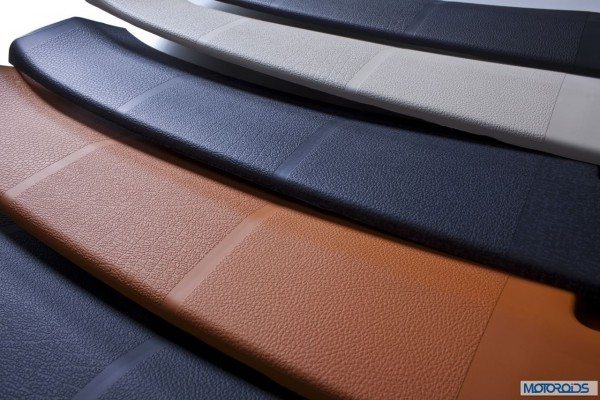Benecke-Kaliko has developed a cost-effective alternative to coated injection-molded parts in passenger and commercial vehicle interiors. It can be used to enhance uncoated injection-molded parts. Decoject™ foils are TPO (Thermoplastic Olefin) based foils with a PUR(Poly Urethane) based lacquer system available with a thickness ranging from 0.2 to 0.5 mm. This foil is back injection moldable only with polypropylene (PP). The foil does not have a grain of its own. The grain is transferred on to the back injection molded component from the engraved tool cavity. DecoJectTM paves the way for new design options for vehicle interiors with an unlimited range of colors, print patterns, and effect coatings including metallic colors combined with any type of grain imaginable. The foil makes it possible to match the color and gloss of the injection-molded parts to other components and to give the feel of coated components thereby enabling designers to create a harmonious environment.
“By contrast, polypropylene injection-molded parts have many inherent disadvantages when used as first-class surfaces,” notes Sven Ullmann, Benecke-Kaliko’s area manager for Asia. These include their interior haptic properties and the fact that they are restricted to comparatively fewer design options. In addition, they are also lack good gloss levels and scratch resistance of first class surfaces. “In some cases, this can partly be overcome with lacquering, but this process is not only expensive, it also comes with its own set of restrictions.” For example, yellowing of PUR coats, coat peel-off in service life and non-visualization of high resolution grains are the common concerns experienced. “Our DecoJectTM foil feels great to the touch and noticeably improves the perceived quality of the injection-molded parts,” says Ullmann. “With semi-glossy or matt finishes available in combination with their soft-feel haptics, they give the components a much more luxurious appearance.” The foil is also particularly scratch-resistant and wear-resistant. Its scratch resistance lends itself well to applications on seat surfaces, door sill protectors or trunk loading sills – everywhere, in fact, where injection molding is currently used and prone to scratching. “The excellent scratch resistance improves the appearance of the vehicle interior throughout its entire service life,” emphasizes Chintan Kanakia, country manager for India at Benecke-Kaliko. In addition, DecoJectTM also offers outstanding resistance to aqueous tenside solutions and other cleaning agents, making it the perfect choice in terms of cleaning criteria for components that are subject to the highest levels of wear and tear.
DecoJectTM can be processed on conventional injection molding machines. To do this, a reverse designed injection mold with foil mounted on the cavity frame is required. The grain is transferred from the mold cavity when the plastic is molded against the foil. Virtually any type of surface can be created, from a leather look to technical grains. After this process, the excess foil is trimmed using laser, blade, or ultrasonic knife trimming methods.
In addition, the thin foil makes it possible to change the interior decor without lengthy setup times and reduces the cost of changing colors: “In order to change the color of an injection-molded part, the entire process chain must first be run down each time, and the new color run in to avoid streaks, for instance,” explains Kanakia. This results in both waste and lost time. DecoJectTM enables the injection-molded part to be continuously produced in one color and then simply overlaid with variously colored foils. The foil can also be used as a means of achieving a uniform surface quality by disguising molding errors, such as seams on support components. All of this helps reduce waste and, as a consequence, conserve valuable resources and thus protect the environment.
“With DecoJectTM, cost savings of up to 45% can be achieved over coated injection-molded parts,” says Kanakia, listing further examples of applications: Door trim parts such as the armrest, insert, decorative elements, upper padding and side pocket, parts of the center console such as the armrest, the lower and mid parts of the instrument panel, steering column, glove box/stowage compartment lids, covers, pillar trims, seat trim strips, backrests and headrests. “Thanks to the improved visual and tactile qualities and a wide range of print and color decor effects, the end customer will also immediately notice the difference in interiors to vehicles in competition ,” explains Kanakia, summarizing the advantages of DecoJectTM again.
Like all Benecke-Kaliko materials, DecoJectTM can be perfectly incorporated into the automotive interior for a harmonious overall effect. The surface designers make sure that all components – regardless of the material used – ultimately look as if molded in one piece, so that the driver feels comfortable. The new TEPEO® Protect and TEPEO 2® Protect surface materials also have outstanding scratch-resistance. They can be used wherever scratches are likely to mar the harmonious appearance of the automotive interior: on the instrument panel, center console, storage compartment, or on door and interior trim. No matter whether on holiday or business trips or simply using the car for running errands, car owners and all passengers can thus enjoy the ride without the irritation of unsightly scratches.
In addition to the foils’ scratch resistance, which is based on a specially developed polymer material, they are also sealed with an ultra friction-resistant polyurethane varnish. This prevents damage caused by frequent polishing with corresponding cleansing materials.

